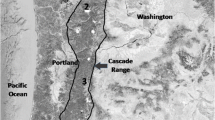Abstract
Previous work on a set of small lakes, of varying depth, themeresof North West England, has shown that nitrogen availabilitycontrols the summer phytoplankton populations in the deeperones(max depth>3 m) and zooplankton grazing in shallow ones. Themeres have generally high total phosphorus concentrations andthismay be a natural phenomenon dependent on the localgeochemistry.Some anthropogenic eutrophication has occurred, however, andfroma chain of three meres, sewage effluent was diverted in 1991.Theupper lake, Mere Mere, lying above the point of discharge, hasnotchanged in any systematic way since effluent diversion. Themiddlelake, the very shallow Little Mere, has changed markedly inwaterchemistry but not fundamentally in ecosystem structure. It wasandremains a clear-water, macrophyte dominated lake. The thirdlake,the deep Rostherne Mere, has shown no response inchlorophyll a concentrations in four years since effluent diversionthough inthe past two years there appears to be a downward trend intotalphosphorus. The reasons for this are explored in terms of ourunderstanding of lake eutrophication. Comparisons are madewithWhite Mere, a deep groundwater fed lake with a long retentiontimeand a very high total phosphorus concentration. The deep meresmayadd a new dimension to our understanding of natural andanthropogenic eutrophication.
Similar content being viewed by others
References
Anderson, N. J., 1995. Naturally eutrophic lakes: reality, myth or myopia? T.R.E.E. 10: 137–138.
Beklioglu, M., 1995.Whole lake and mesocosm studies on the roles of nutrients and grazing in determining phytoplankton crops in a system of shallow and deep lakes. PhD Thesis, University of Liverpool, 425 pp.
Beklioglu, M. & B. Moss, 1995. The impact of pH on interactions among phytoplankton algae, zooplankton and perch (Perca fluviatilis) in a shallow, fertile lake. Freshwat. Biol. 33: 497–509.
Brinkhurst, R. O, & B. Walsh, 1967. Rostherne Mere, England: a further instance of guanotrophy. J. Fish. Res. Bd Can. 24: 1299–1309.
Carvalho, L. R., 1993. Experimental limnology on four Cheshire meres. PhD thesis University of Liverpool, 385 pp.
Carvalho, L. R., 1994. Top-down control of phytoplankton in a shallow, hypertrophic lake Little Mere, England. Hydrobiologia 275/276: 53–63.
Carvalho, L. R., M. Beklioglu & B. Moss, 1995. Changes in a deep lake following sewage diversion–a challenge to the orthodoxy of external phosphorus control as a restoration strategy. Freshwat. Biol. 34: 399–410.
Ganf, G. G. & R. L. Oliver, 1982. Vertical separation of light and available nutrients as a factor causing replacement of green algae by blue green algae in the plankton of a stratified lake. J. Ecol. 70: 829–844.
Griffiths, B. M., 1925. Studies on the phytoplankton of the lowland waters of Great Britain. III The phytoplankton of Shropshire, Cheshire and Staffordshire. Bot. J. Linn. Soc. Lond. 47: 75–92.
Grimshaw, H. M. & M. J. Hudson, 1970. Some mineral nutrient studies of a lowland mere in Cheshire, England. Hydrobiologia 36: 329–341.
Kilinc, S., 1995. Limnological studies on the North West Midland meres, with special reference to Whitemere. PhD Thesis, University of Liverpool, 264 pp.
Livingstone, D., 1979. Algal remains in recent lake sediment. PhD thesis, University of Leicester, 157 pp.
Marsden, M. W., 1989. Lake restoration by reducing external phosphorus loading: the influence of sedimentary phosphorus release. Freshwat. Biol. 21: 139–162.
Moss, B., 1983. The Norfolk Broadland: Experiments in the restoration of a complex wetland. Biol. Rev. 58: 521–561.
Moss, B., 1989. Water pollution and the management of ecosystems: a case study of science and scientist. In Grubb, P. J. & R. H. Whittaker (eds), Toward a More Exact Ecology. Thirtieth Symposium of the British Ecological Society. Blackwell Scientific, Oxford; 401–422.
Moss, B., 1991. The role of nutrients in determining the structure of lake ecosystems and implications for the restoring of submerged plant communities to lakes which have lost them. International Conference on N, P and Organic matter. Contributions by invited international experts. National Agency for Environmental Protection, Copenhagen, Denmark: 75–86.
Moss, B., S. McGowan & I. Carvalho, 1994. Determination of phytoplankton crops by top-down and bottom-up mechanisms in a group of English lakes, the West Midland meres. Limnol. Oceanogr. 39: 1020–1029.
Moss, B., S. McGowan, S. Kilinc & L. R. Carvalho, 1992. Current limnological condition of a group of the West Midland meres that bear SSSI status. English Nature, Peterborough, 320 pp.
Nelms, R., 1984. Palaeolimnological studies of Rostherne Mere (Cheshire) and Ellesmere (Shropshire). PhD Thesis, Liverpool Polytechnic, 128 pp.
Ozimek, T., E. van Donk & R. Gulati, 1990. Can macrophytes be useful in biomanipulation of lakes. Hydrobiologia 200/201: 399–409.
Phillips, G. L., D. F. Eminson & B. Moss, 1978. A mechanism to account for macrophyte decline in progressively eutrophicated freshwaters. Aquat. Bot. 4: 103–126.
Phillips, W., 1884. The breaking of the Shropshire meres. Trans Shrops. Arch. nat. Hist. Soc. 7: 277–300.
Reynolds, C. S., 1971. The ecology of the planktonic blue green algae in the North Shropshire meres, England. Field Stud. 3: 409–432.
Reynolds, C. S., 1979. The limnology of the eutrophic meres of the Shropshire–Cheshire plain–a review. Field Stud., 5: 93–173.
Reynolds, C. S. & E. G. Bellinger, 1992. Patterns of abundance and dominance of the phytoplankton of Rostherne Mere, England: evidence from an 18-year data set. Aquat. Sci. 54: 10–36.
Sas, H., 1989. Lake restoration by reduction of nutrient loadings: expectations, experiences, extrapolations. Academia Verlag Richarz, Sant Augustin, 497 pp.
Scheffer, M., S. H. Hosper, M.-L. Meijer, B. Moss & E. Jeppesen, 1993. Alternative equilibria in shallow lakes. T.R.E.E. 8: 275–279.
Schindler, D. W., 1977. The evolution of phosphorus limitation in lakes. Science 195: 897–898.
Sinker, C. A., 1962. The North Shropshire Meres and Mosses; a background for ecologists. Field Stud. 1: 101–138.
Tallis, J. H., 1973. The terrestrialisation of lake basins in North Cheshire with special reference to the development of a ‘Schwingmoor’ structure. J. Ecol 61: 537–567.
Webb, M., 1924. Precious Bane. Jonathan Cape, London, 320 pp.
Author information
Authors and Affiliations
Rights and permissions
About this article
Cite this article
Moss, B., Beklioglu, M., Carvalho, L. et al. Vertically-challenged limnology; contrasts between deep and shallow lakes. Hydrobiologia 342, 257–267 (1997). https://doi.org/10.1023/A:1017059928028
Issue Date:
DOI: https://doi.org/10.1023/A:1017059928028




